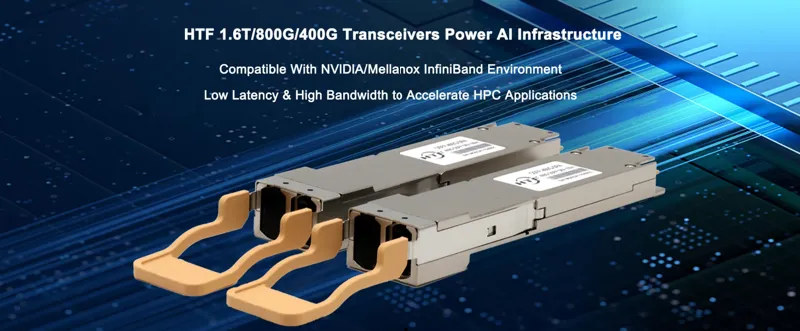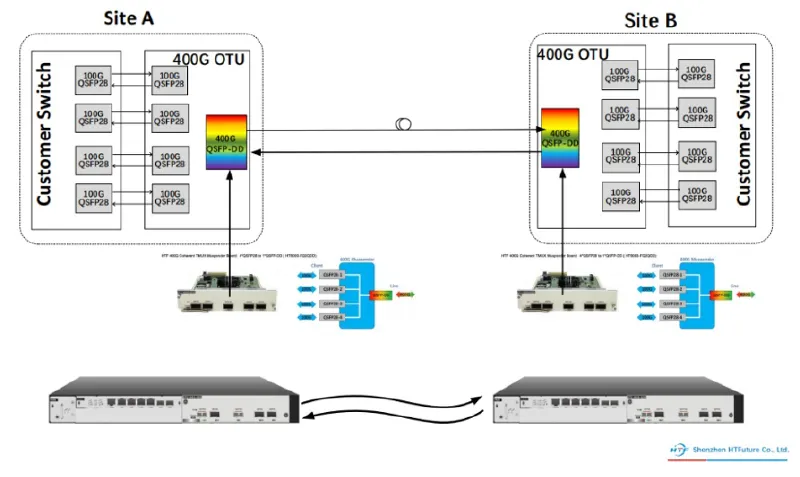Impact of form factor on performance
The performance of a 400GZR module depends heavily on its form factor, including power consumption, cooling requirements, and compatibility with current infrastructure. Typically, this is achieved by using standard form factors such as QSFP-DD (quad small form-factor pluggable double density) or OSFP (octal small form-factor pluggable), which are designed to save space while accommodating high-density applications.
Some large enterprises have found that modules with a smaller footprint tend to have lower thermal output, ensuring system reliability under heavy loads. In addition, signal integrity and transmission distance may be affected by different form factors, as some form factors have additional features such as self-test capabilities. In summary, choosing the right form factor is critical to optimizing network efficiency based on operational requirements.
Checking tunable wavelengths
According to sources from several leading industry players, using tunable wavelength technology in 400GZR modules allows the signal wavelength to be adjusted dynamically, which helps optimize performance in a variety of applications and network conditions. When the wavelength can be adjusted, network design flexibility increases; this allows operators to better utilize the light spectrum and improve signal-to-noise ratios. This means that systems can be quickly reconfigured where they are needed most or when network traffic demands change dramatically. Manufacturers also say that not only does it support more advanced modulation formats, but channel management becomes easier as well – reducing interference levels while increasing overall throughput. Vendors warn that the ability to understand these tunable wavelength capabilities could greatly impact how one plans and deploys networks to accommodate future technology developments or operational goals.
Consider duplexing and mux/demux requirements
When evaluating duplexing and multiplex/demux (mux/demux) requirements for optical modules, it is important to recognize the difference between full-duplex and half-duplex communication methods. Full-duplex systems allow signals to be sent and received simultaneously, which can increase data throughput and reduce latency. In contrast, half-duplex systems alternate between sending and receiving, which can cause communication delays.
Mux/demux configurations are critical to optimizing bandwidth utilization for both multimode and single-mode optical fibers. This means that multiple wavelengths can be combined onto a fiber simultaneously using advanced mux/demux designs to maximize network efficiency and data capacity. According to industry research, manufacturers often offer integrated solutions that incorporate multiplexing/demultiplexing functions into the module, thus improving the overall system architecture and simplifying installation. Ultimately, however, in an increasingly challenging environment, what matters most is whether the different duplexes and the technology behind them are thoroughly analyzed when considering a specific network, as this will help achieve performance goals.
How to implement 400GZR transceivers in optical networks?
Steps to integrating QSFP-DD optical modules
Evaluate system compatibility: Before integrating QSFP-DD optical modules, verify that the existing network infrastructure is compatible with 400G technology. This includes checking available ports and ensuring that network switches and routers support the required transceiver specifications.
Choose the right transceiver module: Select the right QSFP-DD module type based on application requirements such as distance and bandwidth. Standard options include short reach (SR), long reach (LR), and extended long reach (ER). Ensure that the optics are suitable for the intended deployment environment.
Installation process: Follow standard installation procedures, which usually require safely shutting down network equipment, inserting the QSFP-DD module into the designated fiber port and securing it in place to prevent accidental disconnection.
Connecting Fiber: Connect the QSFP-DD transceiver to the network using the correct fiber optic cable. The fiber should be properly terminated and compatible with the transceiver’s specifications, either through LC or MPO connectors, depending on the design.
Power Up and Configure: Once the installation is complete, power up the device and configure the network settings so that the new transceiver is detected. Adjust parameters related to optical performance and monitoring functions, as well as other related parameters designed to optimize network functionality.
Testing and Optimization: Perform comprehensive tests to verify the connection integrity and performance of the QSFP-DD modules within the network. Use diagnostic tools to monitor signal quality, error rates, etc., and make necessary adjustments to improve performance when needed.
Documentation and Maintenance: Document the installation process and the configuration settings adopted, as well as performance metrics, for future reference. Develop a maintenance plan for regular module and software updates to ensure continued reliability and efficiency of the system.
Challenges in Deploying 400ZR Technology
Network operators must address a variety of issues when deploying 400ZR technology to ensure a successful implementation. One of the challenges is related to infrastructure upgrades, as current fiber networks may not be able to support the high bandwidth and low latency required by 400ZR transceivers. In addition, there may be compatibility issues between different types of fiber, especially when they cannot meet the requirements of fast transmission.
Another issue is the complexity of network management and monitoring due to the increase in data rates, which requires more advanced network monitoring tools and technologies. Ensuring proper vendor interoperability can also make deployment difficult, given the need for careful integration and testing. In addition, the costs of equipment upgrades and training employees to effectively handle new technologies are also increasing.
Finally, maintenance and troubleshooting become more complex during 400ZR, as they require special knowledge. Therefore, network performance indicators should be frequently evaluated to keep them in optimal operating condition at all times. These are issues that must be addressed so that we can maximize the use of 400ZR technology to enhance our network capabilities.
Maintenance and care of optical transceiver modules
Optical transceiver modules require maintenance and care to ensure that they work properly over the long term. Physical damage should be checked through routine inspections, as such damage can undermine signal integrity: connector contamination or corrosion. To eliminate dust and other contaminants, it is imperative to clean the optical interfaces with the correct materials, such as isopropyl alcohol and lint-free wipes.
Additionally, monitoring operating parameters, including temperature levels and optical power, can provide insight into the health of the module. This may include having an effective environmental control system, such as maintaining the proper humidity range within the equipment racks used with the transceivers, to further extend their lifespan. Updating the firmware and software of these devices can also help improve performance optimization and incorporate the latest security enhancements. It is also imperative that storage or installation activity handling procedures are properly followed during replacement; otherwise, you may shorten the lifespan of the optical transceiver module.
If want to know more about 400G using and solution, welcome to contact HTF.



